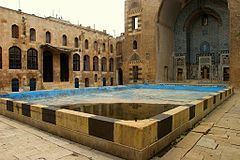Alternative names Qasr Junblatt Architectural style Syrian Completed 16th century Function Palace, Museum | Type Palace, Museum Location Aleppo, Syria Floors 2 | |
 | ||
Address Al-Bandarah, al-Farafira district
Ancient Aleppo Similar Grand Serail of Aleppo, Al‑Hamadaniah Olympic Swimmin, Ri'ayet al‑Shabab Stadium, Al‑Hamadaniah Sports Arena, Al‑Assad Sports Arena | ||
Junblatt Palace (Arabic: قصر جنبلاط); originally Janpolad Palace (Arabic: قصر جان بولاد), is a palace in Aleppo, Syria, built during the 2nd half of the 16th century by the emir of the Jumblatt family, Jumblatt ibn Qasim. In 1604-1605, it has briefly served a residence for the Ottoman wāli of Aleppo Hussein Pasha Janpolad.
Map of Junblatt Palace, Aleppo, Syria
The palace is located at al-Bandarah neighbourhood of al-Farafira district within the walls of the Ancient City of Aleppo. According to the Aleppine historian sheikh Kamel al-Ghazzi, emir Janpolad spent one thousand Ottoman gold lira to build the palace. Since 1766, the palace became the property of al-Kawakibi family. In 1814, its served as the residence of the mufti of Aleppo sheikh Hasan Afandi al-Kawakibi.
Junblatt Palace is believd to have the largest iwan in Aleppo, decorated with fine qashani ceramic-tiled mosaic wall, depicting several Persian-type inscriptions. Like the vast majority of Arabic traditional houses, the square-shaped courtyard of the palace has a large water fountain in the centre mainly used for wudu.
However, many associated external buildings around the palace -including a military barack and stables- were ruined during the 1960s.
